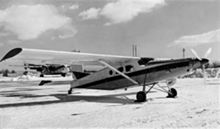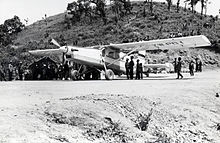- Pilatus PC-6 Porter
-
PC-6 Porter/Turbo-Porter A PC-6 Turbo-Porter, B2-H4 PT6A-34 variant, used for skydiving in Spain Role STOL Passenger and utility aircraft Manufacturer Pilatus Aircraft Built by Fairchild Aircraft First flight Porter - 4 May 1959
Turbo-Porter - 1961.Primary users Civil aviation
United States Air Force
United States ArmyNumber built 562 (as of August 2011)[1] Variants Fairchild AU-23 Peacemaker The Pilatus PC-6 Porter is a single-engined Short Take-Off and Landing (STOL) utility aircraft designed by Pilatus Aircraft of Switzerland. First flown in 1959, the PC-6 has been built in both piston engine and turboprop powered versions, and has been built both by Pilatus and by Fairchild Hiller in the United States. It remains in production as of August 2011.
Contents
Design and development
The first prototype made its maiden flight on 4 May 1959 powered by a 254 kW (340-shp) piston engine. The first Turbo Porter, powered by a turboprop, flew in 1961. The Turbo Porter received an engine upgrade in 1963, which increased its power to its present value of 410 kW (550-shp).
In the United States, the Porter was manufactured under license by Fairchild Hiller. In service with the U.S. Air Force, it received the designation AU-23A Peacemaker. In U.S. Army use, it was designated UV-20 Chiricahua.
Operational history
The PC-6 is noted for its Short Take-off and Landing (STOL) performance on almost any type of terrain - it can take off within a distance of 640 feet (195 m) and land within a distance of 427 feet (130 m) while carrying a payload of 2,646 lbs (1,500 kg) (The length of a soccer field is enough, Pilatus test pilots were able to land on not much more than 164 feet (50 m) of space). Thanks to its STOL performance, the PC-6 holds the world record for highest landing by a fixed wing aircraft, at 18,865 feet (5,750 m), on the Dhaulagiri glacier in Nepal.
Due to these characteristics, they are frequently used to access short grass mountaintop airstrips in the highlands of Papua Province (Indonesia) and Papua New Guinea.
Variants
- PC-6/340 Porter
- Initial production version, powered by a 254-kW (340-hp) Lycoming GSO-480-B1A6 flat-six piston engine. Max take-off weight 1,070 kg (2,360 lb).[2]
- PC-6/350
- As PC-6/340, but powered by a 261 kW (350 hp) Lycoming IGO-540-A1A piston engine.[2]
- PC-6/A Turbo-Porter
- Initial turboprop powered version, fitted with a 390 kW (523 shp) Turboméca Astazou IIE or IIG turboprop engine.[2]
- PC-6/A1 Turbo-Porter
- This 1968 version was powered by a 427-kW (573-shp) Turbomeca Astazou XII turboprop engine.
- PC-6/A2 Turbo-Porter
- This 1971 version was powered by a 427-kW (573-shp) Turbomeca Astazou XIVE turboprop engine.
- PC-6/B Turbo-Porter
- This version was powered by a 410-kW (550-shp) Pratt & Whitney Canada PT6A-6A turboprop engine.
- PC-6/B1 Turbo-Porter
- Similar to the PC-6/B, but fitted with a 410-kW (550-shp) Pratt & Whitney Canada PT6A-20 turboprop engine.
- PC-6B2-H2 Turbo-Porter
- Fitted with a 507-kW (680-shp) Pratt & Whitney Canada PT6A-27 turboprop engine.
- PC-6/C Turbo-Porter
- One prototype built by Fairchild Industries in the USA, powered by a 429-kW (575-shp) Garrett TPE331-25D turboprop engine.
- PC-6/C1 Turbo-Porter
- Similar to the PC-6/C, but fitted with a 429-kW (575-shp) Garrett TPE 331-1-100 turboprop engine.
- PC-6/C2-H2 Porter
- Developed by Fairchild Industries in the USA. It was powered by a 485-ekW (650-ehp) Garrett TPE 331-101F turboprop engine.
- PC-6/D-H3 Porter
- One prototype, fitted with a 373-kW (500-hp) avco Lycoming turbocharged piston engine.
- AU-23A Peacemaker
- Armed gunship, counter-insurgency, utility transport version for the U.S. Air Force. It was used during the Vietnam War in the early 1970s. 35 were built under licence in the USA by Fairchild Industries. All aircraft were sold to Royal Thai Air Force.
- OV-12
- Designation for U.S. version, cancelled 1979.
- UV-20A Chiricahua
- STOL utility transport version for the U.S. Army. Two UV-20As were based in West Berlin during the 1970s and 1980s.
- PC-8 Twin Porter
- Twin-engined version flown in 1967, but not subsequently developed.
Operators
Military operators
- Gendarmeria Nacional Argentina
- Australian Army Aviation - 19 Turbo-Porters were in service with Australian Army from 1968 to 1992.
- 6th Aviation Regiment (Australia)
- No. 161 Independent Reconnaissance Flight
- No. 163 Independent Reconnaissance Flight
- No. 171 Air Cavalry Flight
- School Army Aviation
 Bophuthatswana
Bophuthatswana- Later transferred to South African Air Force
 Bolivia
Bolivia Burma (Myanmar)
Burma (Myanmar)
- Chad Air Force
- Israeli Air Force
- 100 Squadron
- Slovenian Air Force and Air Defence
- Royal Thai Air Force
- Bureau of Royal Rainmaking and Agricultural Aviation
Law Enforcement operators
Civil operators
- Thomas Air
- Mount Cook Airlines
Specifications (PC-6 B2 Turbo-Porter)
Data from Jane's All The World's Aircraft 1993–1994[3]
General characteristics
- Crew: one, pilot
- Capacity: up to ten passengers
- Payload: 1,130 kg (2,491 lb)
- Length: 11.00 m (36 ft 1 in)
- Wingspan: 15.87 m (52 ft 0¾ in)
- Height: 3.20 m (10 ft 6 in)
- Wing area: 30.15 m² (324.5 sq ft)
- Airfoil: NACA 64-514
- Aspect ratio: 8.4:1
- Empty weight: 1,270 kg (2,800 lb)
- Max takeoff weight: 2,800 kg (6,173 lb)
- Powerplant: 1 × Pratt & Whitney Canada PT6A-27 turboprop, 410 kW (550 shp)(downrated from 507 kW (680 shp))
Performance
- Never exceed speed: 280 km/h (151 knots, 174 mph)
- Maximum speed: 232 km/h[4] (125 knots, 144 mph)
- Cruise speed: 213 km/h (115 knots, 132 mph) at 3,050 m (10,000 ft)
- Stall speed: 96 km/h (52 knots, 60 mph) (flaps down, power off)
- Range: 730 km (394 nmi, 453 mi) with maximum payload
- Ferry range: 1,612 km (870 nmi, 1,002 mi) with maximum internal and underwing fuel
- Service ceiling: 8,197 m (25,000 ft)
- Rate of climb: 4.8 m/d (941 ft/min)
See also
- Related development
- Fairchild AU-23 Peacemaker
- Aircraft of comparable role, configuration and era
References
- Lambert, Mark. Jane's All The World's Aircraft 1993–1994. Coulsdon, UK: Jane's Data Division, 1993. ISBN 0 7106 1066 1.
- Taylor, John W. R. Janes's All The World's Aircraft 1965–66. London: Sampson Low, Marston & Company, 1965.
- Taylor, Michael J. H. Brassey's World Aircraft& Systems Directory 1999/2000 Edition. London: Brassey's, 1999. ISBN 1 85753 246 7.
External links
Pilatus Aircraft Aircraft produced by Fairchild Aircraft, subsidiaries, and successor companies Manufacturer
designationsBy role Fairchild (Canada) Fairchild-Dornier Fairchild Hiller Fairchild Republic Fairchild Swearingen American Helicopter XA-5 • XA-6 • XA-8
XH-26
See also:
Ranger/Fairchild aeroenginesUnited States tri-service STOL and VTOL aircraft designations post-1962 Lists relating to aviation General Aircraft (manufacturers) · Aircraft engines (manufacturers) · Airlines (defunct) · Airports · Civil authorities · Museums · Registration prefixes · Rotorcraft (manufacturers) · TimelineMilitary Accidents/incidents Records Categories:- Swiss civil utility aircraft 1950–1959
- Pilatus aircraft
- Military aircraft of the Vietnam War
- Single-engine aircraft
Wikimedia Foundation. 2010.



